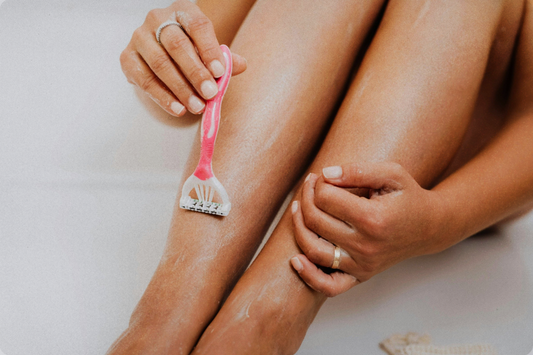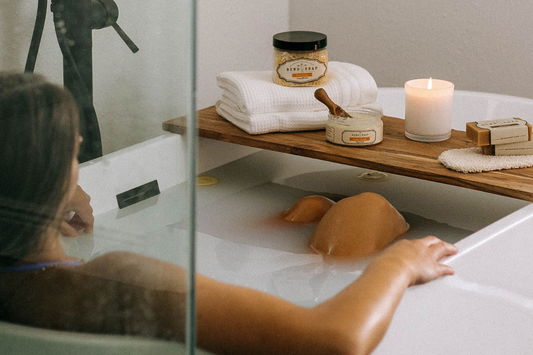Our skin ages through both natural (intrinsic) and environmental (extrinsic) factors like sun exposure and pollution. Aging slows down skin cell turnover, reduces collagen and elastin production, and leads to wrinkles, dryness, and dullness. The best defenses against skin aging are exfoliation, hydration, sun protection, and using all-natural skincare products free of harsh chemicals. Moisturizing regularly, eating a balanced diet, and getting good sleep can significantly improve skin health over time. Starting in your twenties, skin care should become a priority—because the effects of aging compound quickly.
Our bodies may feel the effects of age, but our skin actually shows it with wrinkles, sun spots and spider veins. When it comes to aging, our skin gets a double whammy. It undergoes a process called intrinsic, chronological aging, just like our other organs. But because our skin also faces environmental factors, it also experiences extrinsic aging. This means it’s doubly important to take care of our skin and notice the signs of aging so we can stop them in their tracks!
Let’s dive into what’s happening beneath our skin's surface to expose aging and what we can do about it.
Our Aging Skin
Throughout our youth, skin cells normally take between 30 - 45 days to “turn over” or replace themselves as new skin cells are made deep in the basal layer of the epidermis. New cells work their way to the surface where eventually they die and flake off, revealing fresh new cells beneath. As we age, this process takes longer and is known as decreased cell turnover. Less turnover in our skin cells means that the dead cells hang around longer, resulting in duller, dryer skin. We need to step in and help our skin maintain that healthy glow with exfoliation.
Exfoliating 1-2 times a week is a good place to start. Using a natural physical exfoliant (like one of our all-natural sea salt and sugar scrubs) is a safe way to get glowing skin without overdoing it and causing injury or micro tears.
The older we get, the thinner our skin becomes and the layer that connects the epidermis and the dermis layers begins to flatten. This causes skin to become more transparent and fragile. Normal aging (wrinkles, age spots) as well as photoaging (sun exposure, hyperpigmentation), pollution, and loss of subcutaneous support (the fatty tissue between your skin and muscle) all contribute to how your skin looks and feels.
Think you have some time before you need to worry about aging skin? Think again. Starting in our early twenties, we lose an estimated 1% of our skin collagen every year, and that loss is only accelerated after we hit our forties.
As we age, things are also happening in our dermis, the layer underneath our epidermis. Fibroblast cells begin to think about their own retirement and start to slow production of key proteins and molecules. Fibroblast cells produce collagen, elastin and glycosaminoglycans (say that 3 times fast!). Collagen and elastin are both proteins that are important for keeping skin in ship shape. Collagen contributes to skin's strength and plumpness, while elastin brings skin back to its original shape after stretching. Glycosaminoglycans are molecules that contribute to your skin's natural ability to moisturize itself. These molecules attract water and keep our skin lubricated. With aging, the skin becomes drier, more easily stretched, and weaker, as these important cells start to shut down.
What About the Big W: Wrinkles?
Let’s talk about the most common sign of aging: wrinkles. A life well lived is shown with laugh lines, right? It’s true, we definitely get wrinkles from facial movement, but other things contribute as well.
Fine lines are caused by the irregular thickening of the skin from sun exposure as well as loss of moisture. Both fine lines and deep wrinkles are hallmarks of aging skin that the beauty industry uses to pitch new creams and treatments each year. Despite the endless marketing schemes, the two most important things you can do to prevent and treat wrinkles is moisturize and protect your skin from the sun.

Moisturizing is super important for aging skin, but it’s even more important to use products free of drying alcohols and unnecessary chemicals. After all, our skin goes through enough! Using all-natural skincare products for each step of your skincare routine, like our goat milk soaps for cleansing or our goat milk lotions for moisturizing, will keep your skin smooth and supple. The added power of honey in our Honey Grapefruit Goat Milk Soap will leave skin of all types and ages feeling richly moisturized and aid in healing.
🛈 Pro Tip: Exfoliate regularly to allow the skin to fully soak up these moisturizing benefits! By removing dead skin cells first, you are making way for the moisture to reach deeper layers of the epidermis and have the biggest impact.
What to Do Today to Improve Your Skin Tomorrow
Given all this information about skin and aging, you might be wondering what you can do right now to achieve healthier skin tomorrow. The skincare routine is simple: hydrate, replenish and restore.
Here are some quick tips to help you get better skin:
- Replenishing moisture is key, so make sure you’re sipping on fluids and staying hydrated throughout the day.
- Sleep is paramount to keeping skin looking refreshed, diminishing dark circles, and reducing lines. Sleep position contributes to extra lines on your face and decollage. Try sleeping with a silk pillowcase or training yourself to sleep on your back to eliminate additional stress to your skin.
-
It turns out that refined carbohydrates are bad for the epidermis. Sugars in our diets bind to proteins to form AGEs (advanced glycation end products). These AGEs then bind to collagen proteins making them brittle and easily broken. Give your skin (and hair and nails!) plenty of protein, as well as colorful fruits and veggies. A well balanced diet will help fight against oxidative stress.
- Your daily skin care routine matters! Cleanse, exfoliate, moisturize and protect daily with sunscreen.
The Role of Sun Exposure in Skin Aging
Sun exposure is by far the biggest culprit of environmental stress on your skin. Exposure to the sun results in sunburn and skin cancers, yes, but there is more than meets the eye when it comes to skin damage. The sun's rays contain both UVA and UVB light, both of which contribute to skin cancers. It’s UVB light that causes sunburns, but UVA light is what causes aging skin. UVA light rays are actually weaker than UVB, but they penetrate further down to deeper layers of the dermis and slow the rate of collagen production from those all important fibroblast cells. UVA light also dilates and breaks down blood vessels in the dermis, which is why you get spider veins on your face. One final assault that UVA light takes on your skin is to break down the retinoic acid receptors, which can leave your skin with a vitamin A deficiency.

You may not see the effects of sun damage when you are young, but it builds up over time. In fact, UVA light can damage your skin before you even get a noticeable tan.
While nothing can completely undo sun damage, the skin can repair itself to an extent. It’s never too late to start protecting yourself! Especially if you are at a higher elevation like we are in Central Oregon, the effects of the sun are felt more intensely. So spread a natural sunscreen (or make your own following our recipe!) on your face and body every day to preserve and protect your hardworking skin!
Back to You
Aging skin isn’t just about vanity. Your skin protects and acts as an important barrier from outside bacteria and other invaders. Keep it looking and feeling great with all of these tips and you’ll enjoy great skin that lasts a lifetime.
Frequently Asked Questions
When does aging start to affect your skin?
Skin aging can begin in your early 20s, when collagen production starts to decline by about 1% each year. Visible signs like fine lines may not appear until later, but damage begins early.
Why is exfoliation important for aging skin?
As cell turnover slows with age, dead skin cells accumulate and cause dullness. Gentle exfoliation removes these dead cells, allowing moisturizers to penetrate deeper and improve texture and glow.
What role does sun exposure play in aging skin?
UVA rays penetrate deep into the dermis, accelerating collagen breakdown and causing spider veins, wrinkles, and vitamin A deficiency. Daily sun protection is essential to prevent photoaging.
How can I improve my skin’s elasticity as I age?
Use products with natural moisturizers, avoid drying alcohols, exfoliate regularly, and protect against sun damage. Supporting skin health from within through proper hydration, sleep, and nutrition also helps.
What natural skincare products are good for aging skin?
Goat milk soaps and lotions rich in nutrients and free from harsh additives help replenish moisture, soothe inflammation, and support cell renewal—making them ideal for mature skin.





433 comments
I thought it might be too late for me, but I now know that maybe it isn’t!
Wonderful information
love bend soaps
Such pure and natural ingredients, I especially love the Unscented Lotion and all the bar soaps.
I use these products on a daily basis and just love them !